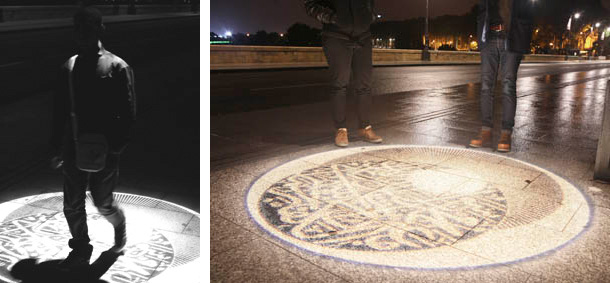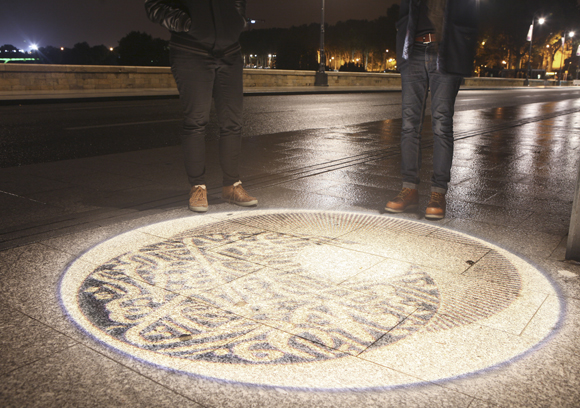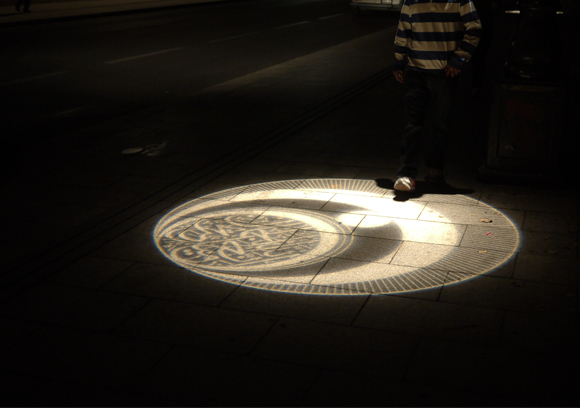| |
|
|
43.
| Technologia |
| |


2012, size may vary, light projections.
Exhibition view of History is Mine!, Le Printemps de Septembre, 2012, Toulouse.
Courtesy of the artist and Ceysson & Bénétière, Paris.
Ed. of 5 + 1 A.P.
With Technologia, mounir fatmi proposes participation in a serious game: what happens when Arabic calligraphy meets contemporary art, and in a broader sense, what happens when it meets different cultures?
Studio Fatmi, February 2017

Technologia
Exhibition view of History is Mine!, Le Printemps de Septembre, 2012, Toulouse.
Courtesy of the artist and Ceysson & Bénétière, Paris.

Technologia
Exhibition view of History is Mine!, Le Printemps de Septembre, 2012, Toulouse.
Courtesy of the artist and Ceysson & Bénétière, Paris.
|
|
|
|
|
|
Technologia est une installation lumineuse et cinétique projetant vingt cinq images circulaires sur un pont où les spectateurs peuvent déambuler librement et se laisser aller à la contemplation d'images fixes ou se succédant à un rythme rapide et saccadé, mêlant motifs géométriques et calligraphie arabe. Sur un écriteau, l'artiste à laissé un message, comme un clin d'œil humoristique et complice : "Ne marchez pas sur les œuvres"... Présentée en 2012 au festival "Le Printemps de Septembre" à Toulouse, Technologia a connu une réception problématique dans l'opinion publique et le monde des arts et est devenue l'objet d'une polémique autour des questions du blasphème et de la liberté d'expression -débat qui a retenu l'attention du public et fini par occulter les intentions initiales de l'œuvre / faire oublier les questions posées par Mounir Fatmi dans cette œuvre.
Technologia est un dispositif aux inspirations multiples qui vont de la calligraphie arabe, à l'art contemporain en passant par la linguistique. Il rappelle les Rotoreliefs à formes circulaires de Duchamp - machines à produire des illusions d'optique qui faisaient se rencontrer les techniques de l'art optique et celles du monde moderne industrialisé, et il renvoie également au travaux de Wittgenstein autour des jeux de langage qui cherchaient à mettre en évidence de quelle manière les significations naissaient des usages et des contextes. Avec Technologia Mounir Fatmi propose de participer à une expérience, un jeu sérieux : que se passe t'il lors de la rencontre de la calligraphie arabe et de l'art contemporain et plus largement lors de la rencontre de différentes cultures ? Dans une acception presque étymologique, le titre de l'œuvre suggère qu'il est également question de l'étude d'un art ou d'une compétence : celle de la machine à associer les signes et celle du spectateur à les percevoir.
Le résultat est un fascinant spectacle de composition et de recomposition permanent, un chaos d'images géométriques s'entrechoquant, et cependant à l'indéniable dimension esthétique. Les images projetées à un rythme stroboscopique, ou simplement fixes, mettent à mal les repères visuels du spectateur à coups de décentrements successifs et ne laissent pourtant pas d'attirer l'œil. Elles tendent également à induire chez le spectateur un état hypnotique de méditation contemplative et active où les signes linguistiques sortis de leur contexte et du cadre de la doctrine religieuse se transforment en motifs abstraits, comme autant d'éléments d'une géométrie nouvelle, d'un monde et d'un rapport au monde sans cesse changeant et renouvelé. Détendez-vous donc, car tout ceci n'est qu'un jeu...
Studio fatmi, Février 2017.
|
|
Technologia is a luminous and kinetic installation that projects twenty-five circular images on a bridge. Spectators can stroll freely and let themselves contemplate images that mix geometric motifs with Arabic calligraphy, which are either fixed in one place or have a rapid and jolting rhythm. On a sign, the artist winks at the viewer with a jocular message: “Do not walk on the artwork” … Presented in 2012 at the Printemps de Septembre festival in Toulouse, Technologia faced problematic reception in terms of the arts and public opinion, and has become the subject of controversy around the notions of blasphemy and freedom of speech. A debate has arisen that has attracted the public’s attention and ultimately obscures the work’s original intentions / makes one forget the questions that Mounir Fatmi presented in this piece.
Technologia is an apparatus that contains multiple inspirations ranging from Arabic calligraphy to contemporary art and linguistics. It evokes the Rotoreliefs with Duchamp’s circular forms - machines producing optical illusions that combine the techniques of optical art and those of the modern, industrialized world, and it also evokes Wittgenstein’s work focused on language games that aimed to demonstrate the way in which meaning was born from customs and contexts. With Technologia, Mounir Fatmi proposes participation in a serious game: what happens when Arabic calligraphy meets contemporary art, and in a broader sense, what happens when it meets different cultures? In an almost etymological sense, the work’s title suggests that it is also a matter of studying an art or a skill: the ability of the machine to associate symbols and the ability of the spectator to perceive them.
The result is a fascinating spectacle of continual composition and recomposition, a chaos of colliding geometric images, and yet there is an undeniable aesthetic dimension. The images are projected with a stroboscopic rhythm or are simply fixed in place, and they challenge the viewer’s visual cues with successive decentralizing motions that do not permit the eye to fixate. They also tend to induce a hypnotic state of contemplative and active meditation for the viewer, in which linguistic symbols have emerged from their contexts. As these symbols emerge from the framework of religious doctrine, they are transformed into abstract motifs as elements of a new geometry, of a world, and of a relationship to a world that is constantly changing and renewing itself. You may relax, for this is all just a game…
Studio fatmi February 2017.
Traduit du français par Christina Washington.
|
|
|
|